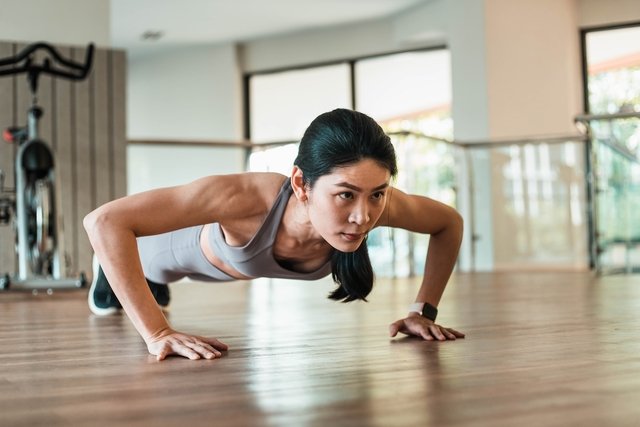The push-up, or traditional push-up, is the best-known variation of push-up that is recommended to mainly strengthen muscles in the chest, shoulders and arms, such as the pectorals, deltoids and triceps, and also improve the body’s balance and posture.
Although they are less popular, there are other variations of this exercise such as the shoulder push-up, military push-up or Nordic push-up, which have different degrees of difficulty, postures and movements. Discover the main types of push-ups.
Even though it is not a seemingly difficult exercise, it is important that push-ups are initially done with the guidance of a physical education professional so that all the necessary guidance is given to perform them correctly.

Benefits of arm flexion
The main benefits of push-ups are:
1. Strengthen chest, shoulder and arm muscles
The main muscles exercised by arm flexion are the pectoralis major, deltoids in the shoulders, and the triceps, making it a great exercise to strengthen the upper part of the torso and complement chest training. Discover the best exercises for chest training.
2. Improve body balance
Arm flexion is a way of training the body’s balance as it is an exercise in which the person needs to maintain constant control of their stability. See more exercises to improve balance.
3. Promote good posture
By also strengthening muscles in the abdomen, lumbar spine and back, which are mainly used to stabilize the body during movement, arm flexion helps improve posture. Check out more exercises to improve posture.
4. Present many variations of the exercise
Due to its variations or types, arm flexion is a versatile exercise, which can be adapted to each person’s physical conditioning and goals.
5. No need for gym equipment
Push-ups are a calisthenic exercise and, therefore, only use your own body weight and can be done anywhere, as long as you have enough space. Find out the most suitable calisthenics exercises for beginners.
Main types
The most common types of push-ups are:
1. Incline push-up
This type of arm flexion uses a bench or elevation on which the hands are supported during the exercise, meaning that less force is needed to perform the movement. It’s a great type of push-up for beginners.
2. Push-up with knee support
The knee-supported push-up is a variation in which the knees are placed on the floor, instead of the toes, to reduce the weight of the body on the arms.
It is best suited for people who have not yet developed enough physical fitness to do traditional push-ups.
3. Closed push-up
The closed arm push-up is a variation in which the main change is in the distance between the hands, which are closer to each other. This means that the innermost part of the pectoral muscles is used more to exert force.
4. Open arm push-up
The open push-up is a type of arm push-up in which the hands are positioned further away from each other, causing the pectoral muscles to contract more external muscle fibers.
5. Decline push-up
The decline push-up is done with the toes resting on an elevation, which makes the exercise more difficult because you need to exert more force with your arms. It is a type of push-up more suitable for people who want greater difficulty.
How to do arm push-ups
The step-by-step guide to doing the traditional push-up is as follows:
- Place your hands on the floor at a distance slightly greater than shoulder widthkeeping fingers facing forward and elbows facing back;
- Stretch your legs backmaking a straight line with the body from head to toe;
- Keep your feet togethertouching the floor with just your fingers;
- Stabilize shoulders above wrists. This is the starting position;
- Slowly lower your body until your chest is close to the floorbending your elbows and keeping them close to your torso;
- Slowly raise your body back to the starting positionpushing the floor with your hands;
- Repeat the movement from the starting position.
During the arm flexion, it is important to keep your abdomen and glutes contracted so that the body does not bend. When bending your elbows, your arms should also form an angle of approximately 45º with your torso so as not to overload your shoulders.
Furthermore, it is recommended that arm push-ups are initially done with the guidance of a physical educator so that the movement is done correctly and avoids injuries.

Sign up for our newsletter and stay up to date with exclusive news
that can transform your routine!
Warning: Undefined array key "title" in /home/storelat/public_html/wp-content/plugins/link-whisper-premium/templates/frontend/related-posts.php on line 12
Warning: Undefined array key "title_tag" in /home/storelat/public_html/wp-content/plugins/link-whisper-premium/templates/frontend/related-posts.php on line 13



